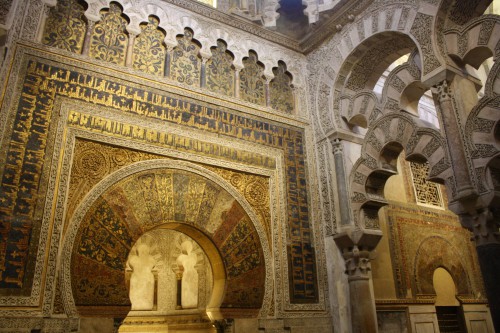3rd October 2012
Is it a mosque? Or is it a church?
Imagine you are in an enormous mosque, over 1,000 years old. You find an architectural style that encourages serene contemplation: a seemingly endless vista of columns culminating in an octagonal mihrab, a sacred focal point for prayer. But then, in the heart of the mosque, you come across a cathedral: an altar, statues of saints and a baroque-style choir. So is it a mosque? Or is it a church?

This is “La Mezquita” in Cordoba, southern Spain. Its history symbolises the mixed origins and influences on that part of Spain. The building was started around the year 600 AD as a church. After the arrival of Islam about 100 years later it was turned into a mosque, but both Christians and Muslims were permitted to use it. The mosque was expanded to reach its current dimensions during the 10th century. The cathedral was built in the middle of the mosque in the 16th century. The building neatly summarises the way both Islamic and Christian religions, art and culture have influenced this part of Europe. And Cordoba also has an area that was a Jewish quarter with a synagogue, reflecting another cultural legacy.
Visiting Cordoba and other cities this summer, I was struck by the lasting, visible legacy of the Arabs – or the “Moors” as they are known locally – on this part of Spain. Andalucia, known as Al-Andalus by the Arabs who ruled from the early 8th century until 1492, contains numerous mosques, palaces and fortresses that illustrate the Arab influence in Spain: a lasting architectural, artistic and cultural legacy.
Another example of this legacy is the Alhambra in Granada, the best-preserved medieval Arab palace in the world. It started as the “Qalat Al-Hamra”, the Red Fort, but in the 13th and 14th centuries the Nasrid dynasty turned it into a series of palaces where the sultan would receive visitors and conduct business while his family enjoyed the shaded gardens and courtyards cooled by water channels, fountains and pools.

The buildings are decorated with elaborate wooden ceilings, fine stucco work and multi-coloured patterned tiles. There are buildings erected by Christian Kings too, creating an interesting contrast of styles. For example, the Arab buildings tend to be rather plain on the outside with extremely ornate interiors. On the other hand, the later Christian palace is classical in style on the outside but was never finished inside.
Many of these buildings are decorated with both Islamic calligraphy and Christian motifs. The Alhambra is covered with Koranic verses notably “Wa la ghalib illa allah” (There is no conqueror but God) alongside complex geometric patterns.
Other aspects of modern Spanish culture such as the guitar and flamenco can also trace origins and influences from the Arab presence. Even the river that runs through Cordoba, the Guadalquivir sounds remarkably like “Al-Wadi Al-Kabir”. And the Spanish phrase expressing hope, “ojala”, bears a similarity to “inshallah”.
Spain rightly celebrates this joint history and fully exploits the tangible legacy of the great Islamic, Jewish and Christian influences on their present culture. Despite the turbulent history, with conflicts and wars between the Moors and Christians, visitors from all over the world can now visit and marvel at these spectacular buildings, the skill of the architects and stonemasons and the beauty of the artistic decorations. The artistic harmony that you can now feel in the palace courtyards and meeting rooms sets a benchmark for the political and social harmony we need to achieve between East and West.
The Mezquita is therefore an important icon: where religious tolerance once reigned and where the architectural mismatch between Islamic and Christian art has nonetheless created a peerless building that people from all backgrounds can appreciate.
Thanks Peter for this interesting insight into a great collection of religious architectures through out the world. A lot more sights can be experienced in the far east as well as the middle east especially Jerusalem and Palestine.
Dear Peter, thanks a lot for this interesting report. Esp. this chapter in which you described so well the Spanish celebrations cause of their joint and common history in. re . of this peacefully “living – together” between Muslims ( “Islamic”), Christians and Jews in Spain. Little I do know about this so far.
But to answer your very 1st. question: A mosque or a church is to me the same: A house of God. Bw, Ingo-Steven, Stuttgart